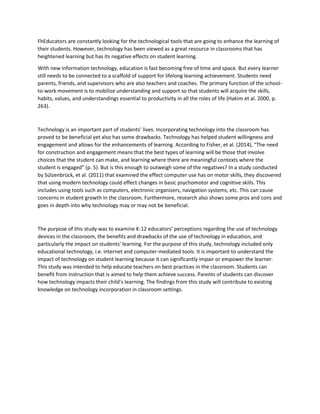
b.docx
- 1. FhEducators are constantly looking for the technological tools that are going to enhance the learning of their students. However, technology has been viewed as a great resource in classrooms that has heightened learning but has its negative effects on student learning. With new information technology, education is fast becoming free of time and space. But every learner still needs to be connected to a scaffold of support for lifelong learning achievement. Students need parents, friends, and supervisors who are also teachers and coaches. The primary function of the school- to-work movement is to mobilize understanding and support so that students will acquire the skills, habits, values, and understandings essential to productivity in all the roles of life (Hakim et al. 2000, p. 263). Technology is an important part of students’ lives. Incorporating technology into the classroom has proved to be beneficial yet also has some drawbacks. Technology has helped student willingness and engagement and allows for the enhancements of learning. According to Fisher, et al. (2014), “The need for construction and engagement means that the best types of learning will be those that involve choices that the student can make, and learning where there are meaningful contexts where the student is engaged” (p. 5). But is this enough to outweigh some of the negatives? In a study conducted by Sülzenbrück, et al. (2011) that examined the effect computer use has on motor skills, they discovered that using modern technology could effect changes in basic psychomotor and cognitive skills. This includes using tools such as computers, electronic organizers, navigation systems, etc. This can cause concerns in student growth in the classroom. Furthermore, research also shows some pros and cons and goes in depth into why technology may or may not be beneficial. The purpose of this study was to examine K-12 educators’ perceptions regarding the use of technology devices in the classroom, the benefits and drawbacks of the use of technology in education, and particularly the impact on students’ learning. For the purpose of this study, technology included only educational technology, i.e. internet and computer-mediated tools. It is important to understand the impact of technology on student learning because it can significantly impair or empower the learner. This study was intended to help educate teachers on best practices in the classroom. Students can benefit from instruction that is aimed to help them achieve success. Parents of students can discover how technology impacts their child’s learning. The findings from this study will contribute to existing knowledge on technology incorporation in classroom settings.